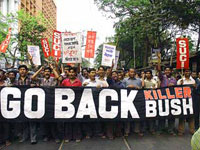Indians protest ‘Butcher Bush’
By
Heather Cottin
Published Mar 8, 2006 11:52 PM
As George W. Bush arrived in New Delhi on
March 2, hundreds of thousands of anti-imperialist protesters from a coalition
of left and Muslim organizations thronged the streets there and in Mumbai
(Bombay), calling him “the greatest terrorist.” Unable to appear
safely in public, Bush had to make his speech to a select audience in the Delhi
zoo. Only rich people, government potentates and some caged animals were there
to hear him.
Bush’s handlers decided he could not appear before the
Indian Congress, where he would face heckles from members of parties angry at
U.S. policies in Iraq and Afghanistan. He couldn’t go to the Red Fort,
another popular site for speechifying, since too many Muslims lived
nearby.
The Bushes stayed at the most expensive hotel in India and took
photo ops with bears and water buffalo. The Indian corporate media reported he
was traveling with 16 canines designated “officers” in the U.S.
Army, which were housed at another posh hotel.
|
Bush burned in effigy in Kolkata.
|
The Indian media
downplayed the huge anti-Bush rallies in the streets, which was hard to do given
the widespread outrage at U.S. imperialism. A coalition of forces joined to
castigate Bush, and even the New York Times took note of their slogan:
“Butcher Bush, get back!”
Indian author and political activist
Arundhati Roy noted in an interview on Pacifica radio’s Democracy Now
(March 3) that the protesters in the streets of New Delhi numbered almost 1
million. She said they included 53 widows from her native state of
Kerala.
In Kerala and the rest of India, “tens of thousands of
farmers have committed suicide because of the closing net of debt around
them,” Roy explained. Economic reforms demanded by imperialist-dominated
banks and the World Trade Organization have favored big agribusinesses and
undermined small farmers all over the world, without providing them alternative
ways to survive.
In some areas of India water and communal lands have
been privatized under pressure from U.S. corporations. These moves have the
support of national and local Indian governments, even in states such as Kerala
and West Bengal, run by communist parties.
The capitalist media tried to
make it appear that those opposed to Bush were primarily from India’s
Muslim population. But the hundreds of thousands of protesters on the streets of
New Delhi and Mumbai and at anti-imperialist demonstrations around the country
came from a variety of organizations that included Muslims, communists and other
anti-imperialist forces.
Demonstrators in the cities of Ahme dabad,
Vadodara, Surat, Siliguri and Bangalore, and in the states of Kerala and
Gujarat, protested Bush’s visit. The huge coalition of forces included
members of the New Socialist Movement and the human rights groups Jan Sangharsh
Manch and Aman Samuday. The flags of the Socialist Unity Center of India (SUCI)
were prominent as demonstrators burned Bush effigies and posters. In Kolkata
(Cal cutta), thousands of people poured off the sidewalks to join a huge
anti-imperialist demo nstration. As police responded with clubs, the city came
to a complete standstill.
Bush’s visit was ostensibly about ending
a decades-long moratorium on sales of nuclear fuel and reactor components to
India, which will allow that country to increase nuclear weapons production. But
many Indians see Bush’s visit as legitimizing and promoting the U.S.
ruling class’s economic domination in India.
The top 10 percent of
India’s population have been growing richer, thanks to U.S. imperialist
economic policies. The rest are being left further and further behind. The UN
Food and Agriculture Organization says that in India in the 1990s, while the
number of millionaires increased sevenfold, the number of hungry people actually
rose.
The U.S. has outstripped Britain, the former colonial ruler, to
become India’s number one trading partner. According to figures on the
Indian Embassy’s web site, U.S.-India trade nearly doubled between 1993
and 2000. From investment in information technology to steel production, U.S.
firms are overrunning India, exploiting cheap labor and natural resources. On
Bush’s trip, the Indian bourgeoisie clamored for more investment, which is
bound to widen the gap between rich and poor.
The system that keeps the
majority of Indians impoverished is profitable for U.S. firms as well as for
India’s dependent bourgeoisie. While the Indian government spends half its
budget on its military, many millions of people are host to intestinal
parasites, since nowhere is tap water safe. There is no electricity in the
countryside just 25 miles outside the capital.
India has the greatest
number of poor people in the world. Of India’s over 1 billion population,
“300 million Indians are earning less than one U.S. dollar a day”
and “800 million people are living below the poverty line.”
(Hindustan Times, March 5)
As the transnationals scramble to sell pro
ducts like Coca-Cola and Pepsi in India, the anger of the people is mounting.
The demonstrations against Bush, whom the Socialist Unity Center called a
“brigand whose hand is tainted with the blood of millions of innocent
people,” express the resistance of hundreds of millions of oppressed
people against the crimes of imperialism and national capitalism, which
subjugate the majority of Indians.
Articles copyright 1995-2012 Workers World.
Verbatim copying and distribution of this entire article is permitted in any medium without royalty provided this notice is preserved.
Workers World, 55 W. 17 St., NY, NY 10011
Email:
[email protected]
Subscribe
[email protected]
Support independent news
DONATE


